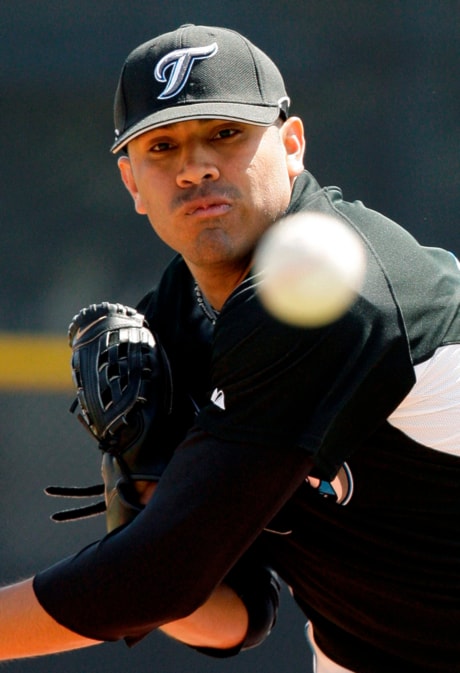TORONTO — It hasn’t led to broken bones or sprained wrists, but it’s still nothing to sneeze at. Pro athletes and amateurs alike have suffered sidelining injuries when a simple ah-choo causes problems ranging from back spasms to — in severe cases — torn muscles.
The Toronto Blue Jays recently lost pitcher Ricky Romero to the 15-day disabled list after the promising rookie sneezed and strained his right oblique muscle.
He’s not the first major leaguer to suffer after-effects from the fierce force of an expulsion of air from the nose.
At the end of February, Braden Looper from the Milwaukee Brewers was scratched from the spring training schedule for an exhibition game after complaining of a tight left oblique muscle.
The suspected cause of the slow start to his season: a sneeze.
In 2004, baseball player Sammy Sosa sneezed twice before going into the clubhouse. The act brought on back spasms and forced him to miss the game as he spent an afternoon in the trainer’s room receiving treatment.
Though the injuries incite chuckles and laughs among sports fans and followers, experts say the quick force is enough to hurt many people.
“When you sneeze, it’s that thrust of a movement that can throw a rib off and you usually feel it in your back as opposed to your abdomen,” says Cindy Hughes, a certified athletic therapist and manager of the Sport Injury Clinic at York University in Toronto.
She has never treated anyone stricken by a sneeze, but says the injury is plausible.
“Injury still happens to high performance athletes where sometimes those little, small muscles are not being trained the way the big muscles are,” says Hughes.
“You just have that explosive movement and all of a sudden: bam, it’s going to hit you.”
Hughes says a forceful sneeze or even a cough, can have enough power to twist a rib depending on where the muscle is located, which means the rib is not in its biomechanical proper placement and can cause swelling and a lot of pain.
“It’s that acute thrust, it’s a dynamic overload of the muscle and when that happens with the muscle, the muscle could potentially tear,” says Hughes, as she paints a worst case sneezing scenario.
But with athletes who train vigorously and are accustomed to battered bones and tired muscles, it’s hard to imagine a sneeze can do this kind of damage.
However, Agnes Makowski the chair of the sport physiotherapy division for the Canadian Therapy Association, will go as far as calling the injury common.
“Just because someone has a six pack with superficial abdominal muscles, it doesn’t mean that the deeper muscles are strong,” says Makowski who, as a therapist, has worked with Olympic athletes.
She says a sneeze hurts a person usually when there are other, unseen issues.
Lower back problems, fatigue and older, untreated injuries are the hidden culprit behind many of these seemingly innocuous actions.
“The other thing with these super fit people is their training schedule is so rigorous and there’s often a lot of pressure to perform. They don’t take sufficient time to rehab,” adds Makowski.
More than anyone else, Makowski says it’s the recreational athlete or the poorly trained “weekend warrior” who can injure core muscles with a sneeze because of underlying weaknesses.
She says it happens because the muscles have fast twitch fibres that respond to quick reaction and when someone is tired and they make a forceful movement, the muscle cannot absorb that kind of stress.
“Sometimes things like a quick or sudden movement, even something like a sneeze, which isn’t a huge amount of force but it’s a quick force when we’re not expecting it, sometimes something like that is the final straw,” Makowski adds.
Some experts say preventing the injury is almost impossible, since plugging your nose to prevent the sneeze can also be dangerous.
“Stifling a sneeze will cause higher pressure than letting it rip,” says Dr. Doug Richards, the medical director of the David L. MacIntosh Sport Medicine Clinic at the University of Toronto.
Richards, who was the Toronto Raptors’ physician for nine years, says in his 27 years of practice he has only encountered five cases where someone strained their abdominal muscles after a sneeze or cough.
He says people can prevent this kind of injury by doing exercises which involve high strength training, but more importantly, high power training.
There is one trick he has learned which can stop a sneeze without stifling the action.
Richards says if a person feels a sneeze coming on they should press their finger under their nose just above the lip and this should stop the motion. They should then blow their nose gently.
“It’s a neat trick,” he adds.
